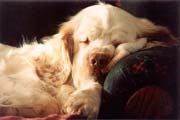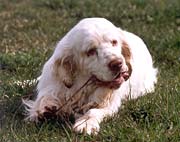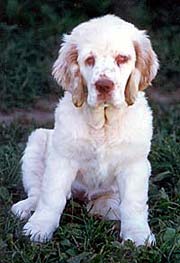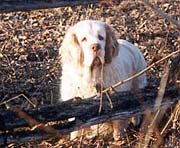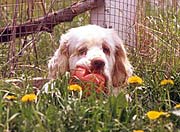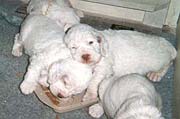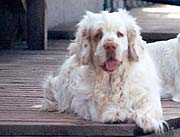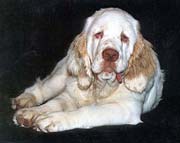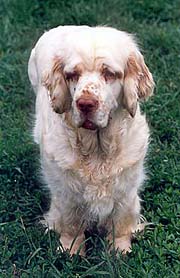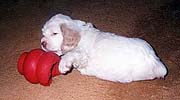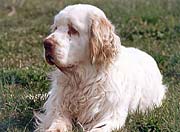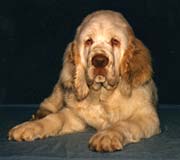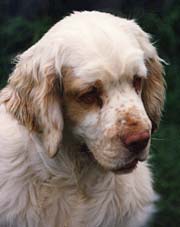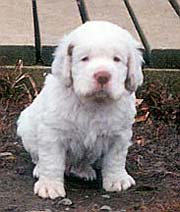Although we are no longer breeding Clumbers, we still have an immense love for the breed. Sweet as they are, Clumbers are not an 'easy' breed for a variety of reasons, and with information sometimes scarce or misleading, and people quickly captivated by that adorable Clumber face, many new owners find out too late that they are completely unprepared for the challenges of the breed. For these reasons we present the following information on Clumbers in hopes that it will help people decide whether the breed truly is for them, and to give some assistance to those who may be feeling a bit overwhelmed in raising their Clumber youngster. |
Clumbers are big dogs in compact packages. Although only 17"-20" tall at the shoulder, they can weigh from 55 to 80lb or more. They are long, low, and heavy, with a sad looking face at one end and a happy wiggly tail at the other. Clumbers are always predominantly white, with lemon (a light tan), or orange (a rust colour) markings in varying degrees. Markings are usually confined to the head such as on the ears, surrounding one or both eyes, and freckles on the muzzle, but it's also common to see a small spot or two on the body and some freckles on the legs. Like many other spaniel breeds tails have traditionally been docked shortly after birth, however as more and more countries, especially in Europe, disallow the practice of docking we are seeing more naturally-tailed Clumbers appearing all over.
An adult Clumber Spaniel can be a wonderful companion. They have great personalities and are generally quite laid back and easy to have around. The downside? - it takes a lot of work to get a Clumber puppy to that stage! I'll talk more about the traits of Clumbers as a breed later on, but for now I want to focus on the trials and tribulations of Clumber puppies.
Clumber puppies can be trying for even the most experienced of dog owners. First and foremost, Clumber puppies are chewers and as such are destructive beyond belief! Keep in mind they're not bad, they just have extremely powerful jaws and when they do typical puppy chewing they can do a great deal of damage. While a Golden Retriever puppy might leave some deep teeth marks on a chair leg, a Clumber will have it reduced to splinters in the same amount of time. This trait can result in far more serious consequences than just the potential loss of a prized possession or two. There are cases of both puppies (and adult Clumbers) who have required surgery to remove ingested items that have then become stuck in their intestines. Some have even died as a result.
A Clumber pup should NEVER be left loose in the house unsupervised! If you can't watch the pup, vigilantly (no getting immersed in a compelling TV show while the puppy wanders around the house unnoticed!), then the pup should be put in a pen or crate where he or she can be safely confined. One word of caution about confining however, it should be done for short periods only, not as a cop-out. If you're not prepared to actively watch a puppy and guide it away from danger and towards positive behaviour, do NOT get a Clumber. Actually perhaps you shouldn't have a dog at all if this is the case, but some breeds are naturally less work to raise than others, so know what you're getting into before you decide on a Clumber.
With a Clumber, puppy proofing the home never ends! Even 'safe' toys should be monitored carefully. Several years ago our then 6 year old Clumber 'Josie' required surgery to remove a piece of a hard black rubber Kong toy from her intestines. We have always been extremely careful with the toys and other objects left around the house, and became complacent that the Kongs were safe (even though our old male, Thomas, could reduce one to shreds in less than a month! He never decided to eat a piece though!). Fortunately she came through surgery fine, and we collected all the semi-destroyed Kongs we had lying around the house, and out they went!
Clumbers have a wonderful, sweet, affectionate, and accepting personality. They can be reserved with people they don't know, so it's important to socialize them well from an early age. Clumber pups must be raised with firmness and consistency, teaching them the rules and boundaries so they'll understand what behaviour we want from them as adults. Clumber pups are adorable, there's no question about it, and as such it's easy to let them get away with murder. If you give in, however, you will regret it later on when that cute puppy is 70+ pounds and trying to tell YOU what to do! I am NOT advocating harsh, 'alpha' methods to "teach the puppy who's boss". That type of training has no place in raising any puppy, in my opinion. Firmness does not mean being physically rough, it simply means setting boundaries and making sure the puppy understands and behaves within them. A Clumber who has been raised permissively and without a clear leader will become an obnoxious adolescent who might growl at you if you want to move him off the couch, for instance, or if you try to take something away from him.
Clumbers can have a tendency towards possessiveness of toys and other objects, so it's especially important to teach a pup from a young to give up items by trading it for a cookie or other toy, and sometimes giving the item back. This way the pup learns that good things happen when he lets you take something from him. Some old style trainers will say you shouldn't tolerate possessive growling of any sort, and they recommend combating it with aggressive behaviour of your own such as getting angry and removing the object immediately. This however only serves to reinforce the cause of the growling - the dog's fear that what he has will be taken away - so the next time the pup will be even more aware of you coming near and will growl louder, since it obviously wasn't enough the first time, and the cycle continues and the problem gets worse. It's much better to simply start out by teaching the pup that it's no big deal and there's no reason for him to be overly possessive. This makes for a much happier relationship, as well as a much safer environment for visiting guests and children too.
Clumbers are stubborn, as they have been bred for years to be determined and single minded to the task at hand. This does make them a whole lot harder to train than, for instance, a Golden Retriever, but by no means makes them untrainable. It simply means that YOU have to find the way to motivate them to do what you want. If there's nothing in it for them, they'll see little point in doing what you ask. It's much easier to try and find what will motivate your Clumber to sit and then reward him when he does, instead of physically trying to force an 80 lb adult male who's built like a tank to put his butt on the ground! The more force you exert trying to push him down, the more he'll push back, determined not to sit! For these reasons it's much easier and more pleasant to use a more positive method such as clicker training, which is based on motivating, shaping, or luring the desired behaviours, and rewarding what you want as opposed to correcting what you don't want. For more information on clicker training, visit our Training page.
One trait that is very common in young Clumbers is submissive urination. Often it seems simply a matter of a happy young Clumber so overjoyed at his mom or dad coming home, or meeting some new friend, that the bum starts to wiggle and, whoops!, they just can't help a little piddling. Be sure not to get angry if this happens, just ignore it and clean up the mess. It is something that they usually outgrow, though it can crop up from time to time as adults too. Keep hellos fairly low key, or have them take place outside where it doesn't matter if the puppy piddles a little. And have patience. It's not something they do intentionally, so there's no point in getting mad or frustrated or make a big fuss.
On the positive side Clumbers are true sweethearts, with bodies perfect for hugging and faces just asking to be kissed. Their coats are so soft you just HAVE to pet them. They're stoic and tolerant, and very little seems to faze them. I swear they could sleep through a tornado, happily snoring away as the house collapsed around them! They generally get along very well with other dogs (though occasionally two intact macho males will have problems together). All of our Beardies have always adored the Clumbers and loved nothing more than to lick their faces while the patient Clumbers just stood there and took it, occasionally grumbling a bit, but the Beardies never believed them! They may have a serious and sad looking face, but whey they're happy their whole rear end wiggles, and they throw their head back and let out the characteristic 'Woo Woo'. I dare anyone to keep a straight face at this!
One thing anyone thinking about getting a Clumber should realize is that Clumbers shed. I don't mean they just shed a little, I mean they SHED!!! Their white coats are exceptionally dense and they shed constantly year round, though it is heaviest in spring and fall. If you've just washed your hands and they're still damp and you pet the dog, you'll suddenly look like you're wearing a white fur glove! If you want a Clumber be prepared for white hair everywhere! If you're the house-proud type then cross a Clumber off your list. If the hair doesn't get to you, the slobber will! Though they're not generally droolers, those droopy flews do collect slobber and when they shake their head they can fling it to the ceiling!
Grooming a Clumber is fairly straightforward for a pet, and only a bit more involved for a show dog. Regular brushing, and a bit of trimming to tidy up the feet and tail is pretty much all that's needed. Ears should be cleaned regularly as the narrow ear canals and long heavy ear flaps can make them prone to waxy buildup and possible infections. When bathing a Clumber, make sure that he is dried thoroughly afterwards, particularly in the 'fold' areas such as the throat. If these are left damp they can easily develop skin problems such as hot spots. Males generally carry much heavier feathering than females so are more prone to matting, but both should be brushed regularly to avoid problems. Mats usually develop in the chest area and under the ears, but also the leg feathering, belly and breeches too.
Breeding Clumber Spaniels is not for the faint of heart. The breed is rare, and seems determined to stay that way. Their long heavy bodies can make natural breedings difficult, so AIs are often done, and whelpings are too frequently plagued by complications such as uterine inertia which can require an emergency C-section. Stillbirths are not uncommon, and defects in pups such as cleft palates and sometimes 'water puppies' can occur as well. These pups are usually euthanized if they are born alive. Losses in the first week due to the new mom unintentionally smothering a pup are far too common as well, so constant monitoring is extremely important. I do believe that selecting for good mothering traits can make a big difference, such as researching lines and choosing a foundation bitch with a background of natural whelpers and conscientious moms, but even then problems can and do occur so it's important to be aware and prepared. Other defects such as umbilical hernias, severe entropion, cryptorchidism (failure of one or both testicles to descend), and bite problems (overshot or undershot mouths) also occur with some regularity. For a more detailed discussion of health problems that occur in the breed, please visit our Health Problems in Clumbers page. Sometimes these will show up in very young pups and can cause problems - some, like the bite problems, can make nursing difficult if it is severe enough at that young an age, so it is vital to monitor pups and chart weight gains etc, on a daily basis. Even pups that appear to have good bites at a young age can 'go off' as they grow, though not usually to the extent that it would cause problems. For this reason show pups are usually not selected until around 4 months when the adult teeth have started emerging and the bite is much more 'set'.
For more information on the breed, visit the following links:







